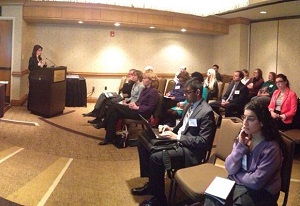On March 7th and 8th, 2013, I joined about 1,000 other attendees in Washington, D.C., to attend the Partnership for a Healthier America’s Building a Healthier Future Summit. The Partnership for a Healthier America (PHA) is a nonprofit organization, developed in conjunction with Let's Move!, devoted to engaging the private sector and bringing together public, private, and non-profit leaders to broker meaningful commitments and strategies to end childhood obesity. I looked forward to attending, partly because PHA had convened a successful summit in November 2011 with First Lady Michelle Obama as a keynote speaker addressing the issue of childhood obesity. But I had other reasons to be excited—NRPA had been invited to speak on our work addressing play deserts.

NRPA's Zarnaaz Bashir, MPH Presenting at the 2013 PHA Summit
So you might be asking yourself, “What exactly is a ‘play desert’?”
Well, we can’t really answer that right now because there is no clear definition – but we are working on it!
What we do know is that there has been a dramatic increase in obesity in the U.S. and rates remain high. We also know that adults and children are not achieving the recommended levels of physical activity a day, and that a lack of opportunities for physical activity is a huge part of the reason. And, of course, we know that the availability of park and recreation facilities and the conditions of those facilities are positively associated with higher physical activity levels. So imagine a neighborhood that lacks spaces available and accessible for use by youth for physical activity and active play. You have to walk miles just to get to the nearest park. That is a play desert.
A little over a year ago, we met with staff at the Centers for Disease Control and Prevention (CDC) in Atlanta, Georgia, to discuss our health priorities and the value that parks and recreation bring to public health. “Play deserts” was highlighted as an area needing further investigation, and there was clearly interest from CDC staff to not only understand what a play desert is, but how to measure and map deserts in an effort to create solutions. And from there, a strong relationship was born. Weekly phone conversations with Carmen Harris (Epidemiologist, Division of Nutrition, Physical Activity, and Obesity, CDC) and Dee Merriam (Community Planner, National Center for Environmental Health, CDC) took place to figure out where to begin, what has already been done, who to involve, and where we’d like to end up.
So, how do you create a definition?
Recognizing that there are a number of researchers and non-profit organizations looking at the play desert issue, we began by convening a “virtual panel of experts” to create synergy around the term ‘play desert’ and develop a definition that is measurable, feasible, and actionable. We wanted to capture as much feedback as possible, and decided to take drafts of the definition on the road to get feedback at conferences such as NRPA’s Annual Congress in 2012 and the Active Living Research Conference, and then at the PHA Summit just this month. What we learned through these discussions are the following:
1. Play deserts is not just about whether a park exists or not, but about the quality of the park, how accessible the park is, and whether the park is being used;
2. Most people are comfortable with the term “play desert” but “play” does not necessarily equate to physical activity;
3. The definition will not only be useful to local park and recreation professionals, but to researchers, planners, and community organizations; and
4. We must engage local communities to validate the definition!
When Carmen Harris and I presented at the PHA session, we were extremely pleased to see the response from the audience. Attendees representing non-profit organizations, foundations, and advocacy groups were eager to share their perspectives on play deserts and the various solutions they’re implementing to address them. It is our hope that once the definition becomes available in the coming months, local park and recreation professionals will use it in ways that are helpful to them, whether it be to advocate for additional funding or to demonstrate the value of parks and recreation. It is also an opportunity to reinforce how parks and recreation provides solutions through the provision of health and wellness and by providing access to those opportunities for all people – two of NRPA’s core Three Pillars.
By drawing attention to this important issue of play deserts and highlighting solutions through parks and recreation, we get one step closer to building healthy, active communities.
How would you define a play desert? What are some solutions your agency has put into place to combat play deserts?
Zarnaaz Bashir is NRPA’sDirector of Health Initiatives.

